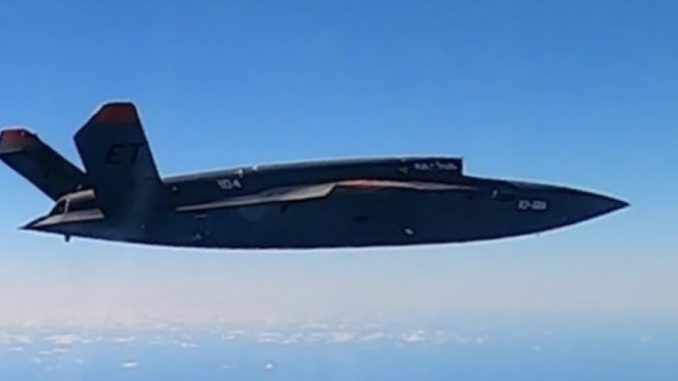
In what may be both another sign of the mainstream adoption of artificial intelligence as well as the potential genesis of Skynet, defense contractors are looking to leverage AI on the battlefields of the future. One such company is Kratos Defense and Security Solutions, creator of the unmanned XQ-58A fighter jet—also known as the Valkyrie.
The Valkyrie is an experimental stealth fighter that first took flight without any humans aboard in 2019. The XQ-58A fighter had its most recent successful flight in February, Kratos Defense said, flying in formation with other US Air Force planes.
“As a loyal wingman, the XQ-58 can be employed as an off-board weapon engaged in a denied environment, enabling the [human] fighter pilot to remain in a less vulnerable position and farther from the threat,” Steve Fendley, president of the Unmanned Systems Division at Kratos, told Decrypt in an email.
Initially launched in 1994 as Wireless Facilities Incorporated to provide telecommunications services, the San Diego-based company rebranded to Kratos Defense & Security Solutions in 2007. It shifted its focus to providing services to the US Government—specifically the US Department of Defense.
In June, Kratos Defense tapped artificial intelligence developer Shield AI to integrate an AI aviator into the Valkryie to enhance the fighter’s capabilities and develop intelligent, and—hopefully, for US taxpayers—affordable AI options for the US military.
Fendley did not say what type of security protocols the Department of Defense requires, but told Decrypt that Kratos follows DoD standards for its unmanned aircraft and assets and that there are multiple levels of US government security measures in place for both physical and digital interfaces.
“The Valkyrie is changing the paradigm for tactical UAS technology and affordability,” Fendley said. “We expect the XQ-58 to play a leading role in fielded operational, tactical [Uncrewed Aircraft System] for the US military branches, and our current programs and internal efforts are paving the way.”
An Unmanned Aerial Vehicle or UAV refers to an aerial vehicle or drone that does not require an onboard pilot. On the other hand, an Uncrewed Aircraft System or UAS refers to an entire system that supports and controls the UAV independently, including ground control stations, software, and communication systems.
“The technologies involved in each of these areas is evolving rapidly,” Fendley said. “However, the real focus is on the right mix of specific operational missions, leveraging the current state of the multiple technologies to validate and demonstrate the substantial increase in offensive and defensive capability [that] these systems give the warfighter.”
Fendley says the DoD has several programs focused on implementing AI and unmanned systems and readying them for operational use, adding that the work will continue to ramp up.
On Wednesday, the Defense Advanced Research Projects Agency (DARPA) announced the launch of a two-year AI Cyber Challenge that aims to leverage the brightest minds in AI to identify and fix AI vulnerabilities. Meanwhile, US Department of Defense said that the military is also conducting tests to leverage generative AI. Generative AI is a type of artificial intelligence that can create new content—such as text, images, or music—using prompts.
Fendley says the next steps for Kratos include refining the balance between crewed and uncrewed missions while emphasizing the cost benefits of systems like those built by Kratos Defense, including its Valkyrie, Mako, and Tactical Firejet projects.
“Our focus has always been on affordability and being first to market with breakthrough technologies like the XQ-58—at a low cost—with actual products, systems, and technologies rather than slide decks or renderings,” Fendley said. “We believe that’s set us up for success for today’s budgetary environment and world events, which necessitate that we move quickly and keep an eye on budget.”




Be the first to comment